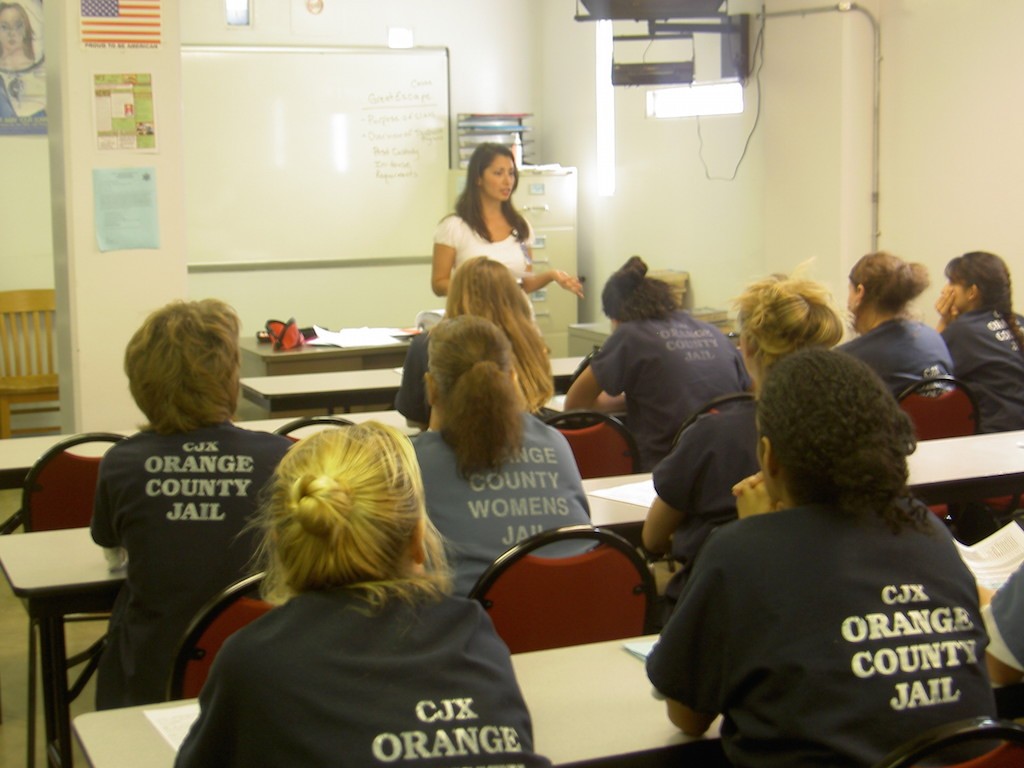In the end, convicts were sent off with whatever they came in with and well wishes for the future.
For however long their sentences stretched, inmates in Orange County found some semblance of stability in the routine meals, stringent schedule and work assignment within the jail’s walls.
Many also participated in programs intended to set them on a better life path, whether it was continuing their education, committing to a substance abuse recovery program or learning to be a better parent.
But when they were released, so were the resources they accessed on the inside.
Then came the crapshoot — would they offend again?
The answer, all too often, was yes, prompting the Orange County Sheriff’s Department to find ways to improve the odds.
Nearly a decade ago, OCSD’s Inmate Services Division revamped the way it offers resources to the incarcerated — a concept that remains fluid and complex, but makes post-release assistance a priority.
“Years ago, when inmates got out they were basically sent off and we said, ‘Good luck,’” said Dominic Mejico, administrative manager in the inmate services division. “Now, if you took parenting classes with a religious group, you can continue those when you get out. If there’s a mentoring program you participated in, that same mentor would work with you when you get out.”
Focusing on what happens after inmates leave increases the chance for rehabilitation, officials say.
“Our philosophy is it would be better to give them some skills to cope with when they come back to our communities, as opposed to giving them nothing,” said Greg Boston, director of inmate services. “Giving them skills to improve their life so they can be a functioning member of society is the ultimate goal.”

Volunteer teachers lead a variety of classes to help prepare inmates for life on the outside. Education courses, food certification classes and parenting groups are among the most popular program in Orange County’s jails. Photo courtesy OCSD.
Science in serving time
More than 70,000 people are ushered through Orange County’s jail facilities each year, with 6,000 housed in five county facilities at any given time.
OCSD staff in charge of jail programs are tasked with homing in on a very specific inmate population: those most likely to end up in a jumpsuit after release.
“For the most part, we’re not dealing with offenders who have committed murder, rape and those kinds of violent crimes. Those individuals won’t be reoffending because they will be in custody for a very long period of time,” Mejico said. “We try to service the people who are going to end up in our neighborhoods again.”
OCSD staff conducts a science-based evaluation with every inmate to determine what factors may have played a role in their incarceration, including age and criminal history.
This helps identify the inmate’s risk level, which has nothing to do with how dangerous the offender is and everything to do with whether or not he or she will again succumb to a criminal lifestyle on the outside.
Someone who is considered high risk will go through a second assessment to find which programs will benefit them most. Staff reviews education, substance abuse history, family dynamics — the list goes on.
“There is a point of view from some that there should be a sense of punishment when you’re incarcerated,” said Geoff Henderson, programs and services manager. “Being separated from society is your punishment, not what happens to you while you’re there.
“More than 90 percent of the people in our jails are going to come back to being our neighbors. It is in society’s best interest to encourage and support these kinds of programs.”

The Orange County Sheriff’s Department runs more than 50 programs for inmates at its five facilities. Photo courtesy the OCSD.
Picking the programs
The state mandates some services and programs including access to religious services, recreation, civic activities and a basic education.
OCSD is afforded some creativity in choosing which non-required classes would bolster rehabilitation, with the most popular being computer skills courses, parenting classes and food- handling certification courses.
Financial literacy classes, self-esteem enhancing courses and an inmate dog training program also are on the list of more than 50 opportunities for Orange County’s incarcerated.
“We don’t put programs together just for fun,” Mejico said. “They’re going to leave with something tangible, which is going to help them with a job when they get out.”
Volunteer-run courses make up the majority of the jail’s programs, followed by contracted classes offered in partnership with local community colleges.
OCSD also takes advantage of grant funding earmarked for California jail programs.
The department last year launched OC LEAP (Linking Employment, Abilities and Potential) in its men’s facility.
The program, funded by the state Department of Labor, is a partnership with Goodwill Industries of Orange County to offer inmates career services, such as resume preparation, interview training, access to job boards and job placement services.
“The program looks to eliminate any barriers to help get inmates employed after their release,” Henderson said.
OC LEAP was recently recognized by the National Association of Counties as an innovate program in criminal justice. The program has been so popular OCSD is expanding it to the women’s facility, but in partnership with the nonprofit Working Wardrobes.
Anecdotally, the paradigm shift in rehabilitation practices is working, but attaching measurable results to the concept proves difficult, officials say.
But officials say they will continue to innovative, review programs, and swap out those dwindling in effectiveness, when needed.
There is always work to be done, Henderson said.
“We are really working on getting inmates to a place where they can make positive changes,” he said. “We have to understand what our limitations are, and even with all of this there are still gaps.”
But OCSD is making headway on filling one of those very large and complex gaps.
Today when a sentence ends, many inmates are sent off with whatever they came in with, well wishes for the future and a plan to find some semblance of stability — this time, outside the jail’s walls.
 Behind the Badge
Behind the Badge




